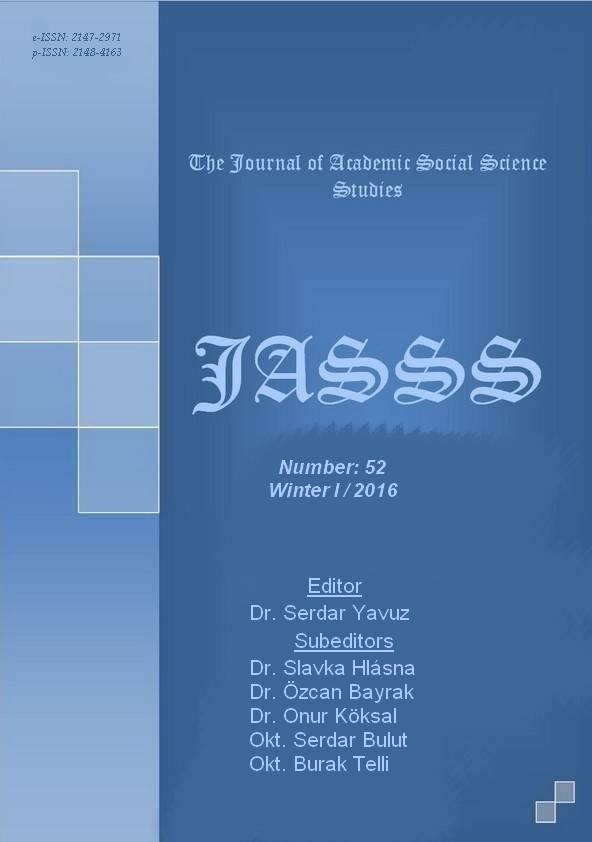Author :
Abstract
Bir ülkenin ihracatını etkileyen en önemli unsur reel döviz kurudur. Reel döviz kurunun artması, yurtiçi malları yabancılar için ucuz hale getirmekte ve ihracatı arttırmaktadır. Bretton woods sisteminin yıkılmasıyla, sabit kur sistemi terk edilerek, kur değerinin piyasada arz ve talep koşullarına göre belirlendiği esnek döviz kuru sistemine geçilmiştir. Esnek döviz kuru sisteminde belirsizliğinin artması ihracatın olumsuz etkilendiği tartışmalarını gündeme getirmiştir. Döviz kuru belirsizliğinin ihracat üzerine etkilerinin ortaya konulması politika yapıcılar için oldukça önem kazanmıştır. Bu çalışmada, döviz kuru belirsizliğinin Osmaniye ili ihracatı üzerine etkilerinin ortaya konulması amaçlanmıştır. Bu amaçla olası etkinin varlığı, 2004:01-2016:02 dönemi reel döviz kuru ve Osmaniye ili ihracat verileri kullanılarak sınanmıştır. Bu anlamda döviz kuru belirsizliği, kurdaki dalgalanmalar yardımıyla oluşturulmuş ve bu amaçla Hodrick-Prescott trend ayrıştırma yöntemi tercih edilmiştir. Söz konusu değişkenler arasındaki olası ilişkinin sınanması amacıyla Pesaran vd. (2001) tarafından geliştirilen ARDL sınır testi yaklaşımı kullanılmıştır. Elde edilen ampirik bulgular sonucunda, söz konusu iki değişken arasında uzun dönemli bir ilişkinin varlığı kabul edilmiştir. Ancak uzun dönemli ilişkinin büyüklüğünü ve işaretini ortaya koymak amacıyla oluşturulan ARDL modelinden elde edilen bulgular, uzun dönem katsayısının istatistiksel olarak anlamlı olmadığını göstermiştir. Osmaniye ili ihracatının dalgalı döviz kuru uygulamasına geçilen tarihten bu yana artış göstermesinin, krizler nedeniyle daralan iç talep karşısında üreticilerin dış satıma yönelmelerinden kaynaklandığı düşünülmektedir. Ayrıca, Osmaniye dış ticaret partnerlerinin 2008 ekonomi krizinden en az etkilenen ülkelerden oluşması da ihracat rakamlarında meydana gelen artışın nedeni olarak verilebilir.
Keywords
Abstract
The most important factor which effects the country’s export is a real exchange rate. The increase in the real exchange rate makes domestic products cheaper for foreigners and increases export. With the collapse of Bretton Woods system, it was adopted to flexible exchange rate which exchange rate is determined by supply and demand in the market, instead of fixed exchange rate. Increased uncertainty in flexible exchange rate system led to argument that export was effected negative. To reveal the effects of the exchange rate uncertainty on export has highly important for policy makers. In this study, it is aimed to clarify the effects of exchange rate uncertainty on Osmaniye export. For this purpose, the existence of the possible relationship between export and exchange rate uncertainty was tested by using exchange rate uncertainty and Osmaniye export data for the period of 2004:01-2016:02. In this regard, Hodrick-Prescott (1980) decomposition analysis was preferred in the study in order to determine the exchange rate uncertainty with the help of exchange rate volatility. With the purpose of determining the existence of a possible relationship between two variables, ARDL bound test developed by Pesaran et al. (2001), was applied. In the result of findings, it is accepted that there is a long run relationship between relevant two variables. But, the findings acquired from the ARDL model, which is established to find out the direction and magnitude of the long run relationship showed that the long run relationship coefficient isn’t significant. Since the adoption of flexible exchange rate regime, rising of Osmaniye export is believed to arise that manufacturers turn to foreign sales in the face of shrinking domestic demand by 2008 economic crisis. In addition, the foreign trade partners of Osmaniye, composed of the least affected countries from the economic crisis in 2008, can also be given as to why the increase occurred in the export figure.





